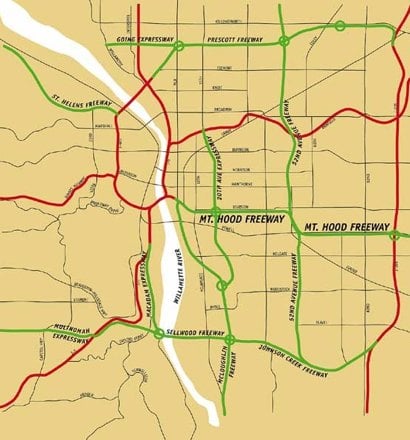I recently came across this image again — it’s the map that might have sealed our fate, developed by Portland city planners in 1966 in response to freeway guru Robert Moses’ vision for the city.

Moses was known for saying “Cities are for traffic,” and he dedicated his career to creating freeway networks inside cities, many of which cut across existing neighborhoods — often the poorest ones.
This map is fascinating. The red lines represent freeways already built. The green ones were planned. Look at how North Going Street, which is slated to be part of one of Portland’s next bike boulevards, would have been a huge expressway. Can you imagine Alberta Street being what it is now if Prescott had been a freeway? And what would have happened to the neighborhoods around SE 20th and SE 52nd?
The green lines are planned freeways, and the Mount Hood Freeway was the first of these that would have been built. It was stopped by a strong grassroots effort, with the support of local political leaders. After that, none of the other projects got rolling, and much of the money that was appropriated for the freeway instead went into other transportation projects like the first MAX light rail line.
For more background on the Mount Hood Freeway fight, check out this Willamette Week story, and this Streetfilm on the topic. And there’s an overview on Wikipedia of the anti-freeway activism that was rampant in that era, with widely varying results.
We’re lucky to have escaped the fate of many other cities — but I hope we are not getting ready, with the Columbia River Crossing project and all the stimulus spending in our near future, to make some of the same mistakes that we avoided forty years ago.

